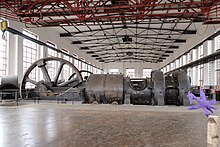Coke oven gas
Coke oven gas is obtained by pyrolysis (dry distillation) of hard coal in coking plants . The cleaned coke oven gas with town gas quality has a calorific value of 15.5 to 18.9 MJ / m³ (4.5 kWh / m³), which is about half as high as the calorific value of natural gas .
description
A large number of gaseous substances are produced during coking. The cleaned coke oven gas has the following components, which vary depending on the coking plant and the coal used: 55% hydrogen , 25% methane , 10% nitrogen and 5% carbon monoxide . The raw gas still contains the following components: carbon dioxide , ammonia , hydrogen sulfide , higher hydrocarbons and aromatics , which are largely removed.
During coking, around 25% of the coal used is produced as volatile components. One ton of coal yields 280 m³ of clean coking gas and approx. 55 kg of sticky coal tar . The coke oven gas is sucked out of the gas collecting space above the bed from the coke oven. By cooling with water, tar is deposited. The raw gas is cooled and cleaned in gas washers. The constituents that interfere with the use of gas, such as hydrogen sulfide, ammonia, benzene and aromatics such as naphthalene, are largely removed and these are further processed as so-called carbon materials. This gas is known as partially cleaned coke oven gas or coke gas. In coking plants that are not integrated into a furnace gas network as a hut coking plant , it is sometimes used to fire under the coke ovens.
Process for processing the raw gas
The distillation products formed during coking flow from the coke oven at around 700 ° C. into the riser pipes and are collected in the receiver. This is followed by the gas pre-cooler, in which the temperature is lowered to 30 ° C and most of the tar and water condense out. In the separating container, tar and water are separated due to the different polarity and density.
To Entteerung the raw gas have since the 1950s electrostatic precipitator enforced. Compared to the previously used mechanical tar separation, the process has a very low pressure loss and residual tar contents of 20 mg / m³ are achieved in the clean gas.
The ammonia is washed out according to the Koppers process by washing with sulfuric acid water. The gas is first cooled to 35 ° C in order to still deposit residual tar and then the dried gas is heated again to 85 ° C. The water introduced during the neutralization of ammonia with sulfuric acid is absorbed by the gas as steam. Due to the almost complete separation of tar before it enters the saturator , a very pure crystalline ammonium sulfate is formed, which is used as fertilizer.
The coke oven gas is debenzened by washing with coal tar oil, the boiling range of which is 200 ° C to 300 ° C. There are columns with washing cap trays or expanded metal inserts used. The saturated washing oil is then heated by adding steam and the benzene is enriched to a commercial quality in several stills connected in series.
A large number of cleaning processes have been used in the past for desulfurization. Oxidation, neutralization and absorption processes have been used as wet processes and, depending on the process, sulfur or hydrogen sulfide is obtained. A bed of iron oxide hydrate (e.g. lawn iron ore) is used in the dry process for fine gas cleaning in the high-pressure stage. The coke oven gas is passed through standing columns in which baskets with the cleaning compound are inserted.
Coke oven gas distribution

Until the 1960s, the public gas supply was based on the use of town gas, which in industrial conurbations (e.g. the Ruhr area) was mainly obtained from coke oven gas. For this purpose, the gas was compressed to a higher pressure required for a long-distance pipeline and subjected to further cleaning and drying. This is necessary in order to further separate corrosive components and to prevent the separation of components in the pipeline network. Furthermore, the hydrogen sulfide content had to be further reduced by binding to turf iron ore in order to avoid sulfur dioxide emissions at the point of combustion. Town gas was mostly used for cooking and lighting purposes in the first half of the 20th century. Due to the closure of coking plants and competition from natural gas, the area-wide distribution of town gas was discontinued in the 1960s, and the coke oven gas has since been used in its own network or in association with large gas consumers.
With the founding of Ruhrgas AG in 1926, coking plant clean gas became the new town gas and it formed the business basis of Ruhrgas AG for over 40 years.
See also
literature
- Michael Farrenkopf: Coke - the story of a valuable material. Bochum 2003, ISBN 3-921533-90-2 .